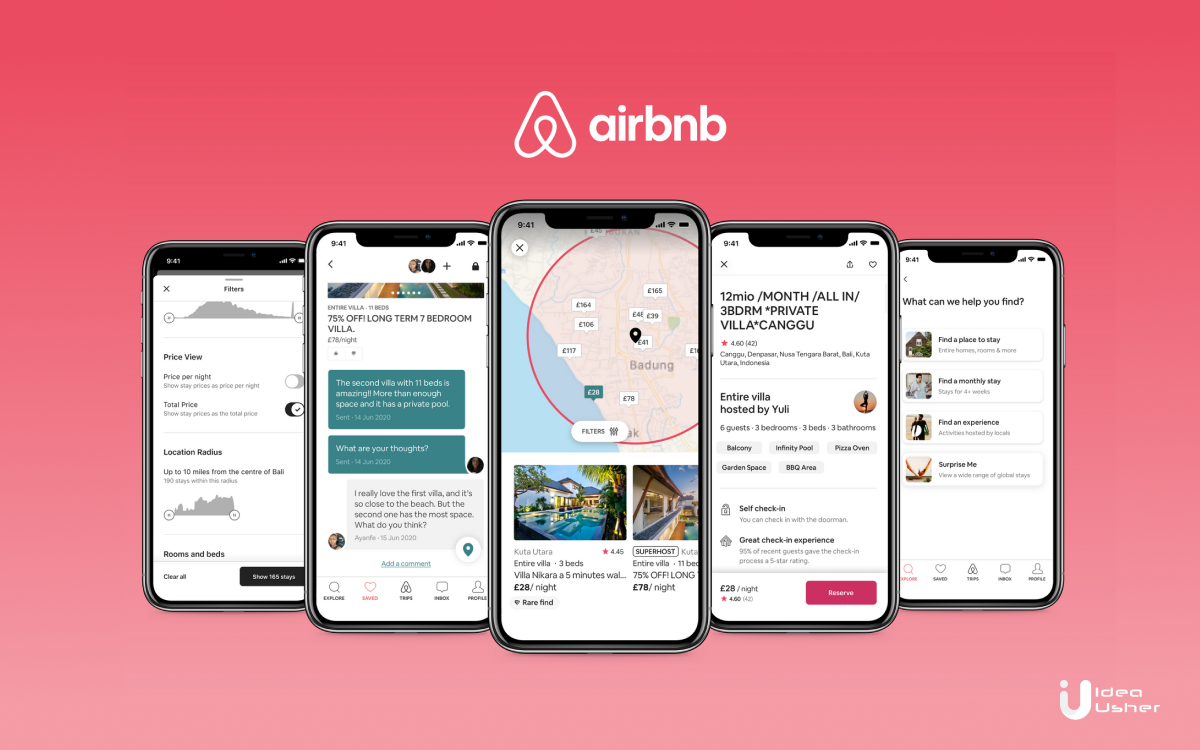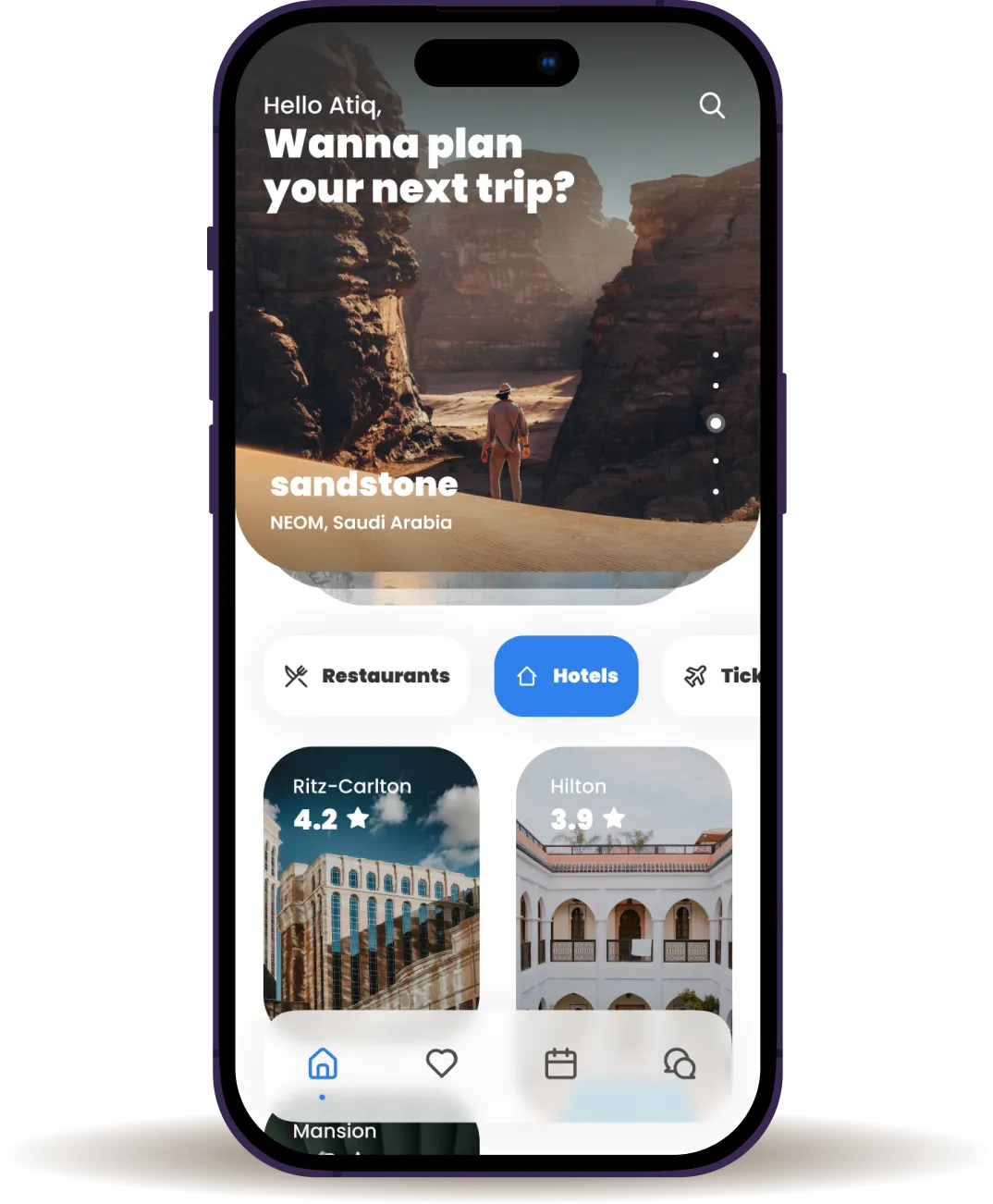Airbnb is one of the best examples of a “sharing economy” company. It has changed the way people travel. The platform offers vacation home rental services by providing an opportunity for homeowners to rent out their homes to travelers. If you are looking for ways to build an app like Airbnb, you have certainly landed at the right place.
As the travel industry recovers from the pandemic shock, this presents the right circumstances to develop a home-rental app! This blog explores how Airbnb works, the Airbnb business model, the tech stack powering the app, and, most importantly, the steps to develop an Airbnb-like application. So, read on as you try to shake up the vacation home-rental industry with your entrepreneurial mind!
Airbnb: A Briefing To What It Is!
Airbnb.com is a home-rental website where hosts list their homes for rent, and guests can find and book them. A person or a company creates each listing on Airbnb. None of the rental homes are owned by Airbnb.

In many ways, Airbnb is a one-of-a-kind enterprise. It popularized the concept of “home-sharing” and altered people’s perceptions of staying in a stranger’s home while traveling. Before Airbnb, most individuals would only consider it if they already knew the person hosting them. That is no longer true as the internet and technology revolutionize social structure worldwide!
Without a doubt, this app has scripted one of the most successful travel app stories in the last decade. Its success can be attributed to certain elements that are essential for growth. It includes perfect timing, outstanding execution, and rapid global expansion. The Airbnb model has also changed the way its users view vacationing. It is easier for them to have a unique experience in a foreign country.
A Short Overview Of Airbnb:
|
App Name: |
Airbnb |
|
CEO: |
Brian Chesky |
|
Founded In: |
11 August 2008 |
|
Annual Revenue: |
3.378 billion USD (2020) |
|
Total Downloads: |
1,220,231 (Google Play Store, as of 11-01-2022) |
|
Number Of Hosts: |
2.9+ million (2021) |
|
Top Competitors: |
Booking.com, Vrbo, Flipkey, HomeToGo |
|
Platforms: |
Android, Apple iOS |
|
Average Ratings: |
4+ (Google Play Store) |
|
Subsidiary Companies: |
Tilt , HotelTonight , Luxury Retreats · Gaest.com , DailyBooth , Luckey · localmind , Trip4real , Trooly (Acquired by AirBnB) , Minbox |
How Does Airbnb Work For The Guests & Hosts?
Let us cut it straight to how Airbnb works for a guest.
- The user downloads the application and completes the registration process as a guest. The user can add necessary data such as profile picture, ID number, etc.
- Once done, the user will get an entry to the Airbnb home screen. Here the user can search for a location.
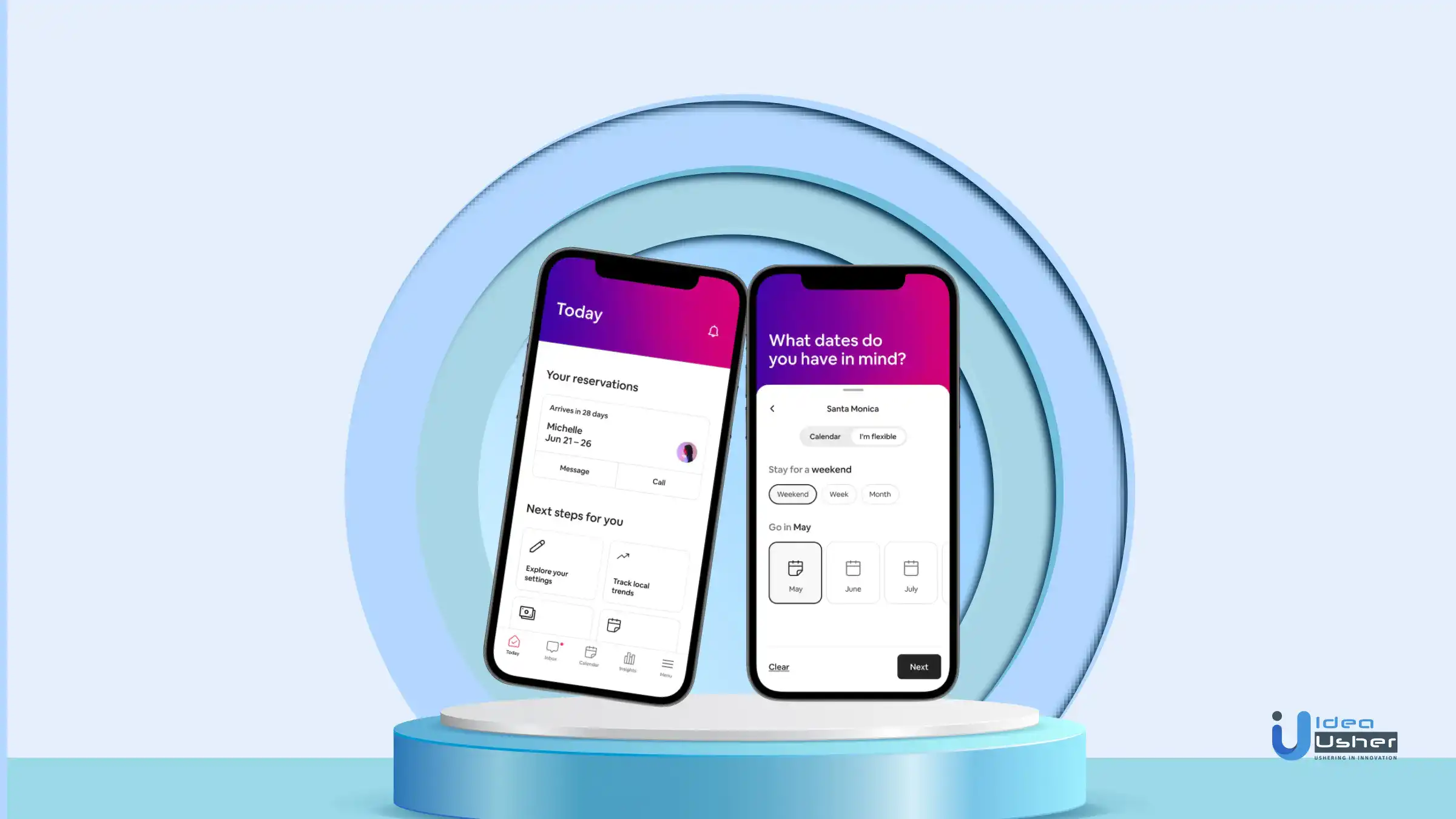
3. Once the user searches for a location, Airbnb has much to offer. It includes sections for Stays, Experiences, Adventures, and Restaurants.
4. The user can move to the Stays section to rent a space where they can stay. There are options like Dates, Guests, Work Trips, and Filters.

5. Upon requesting a Stay, they get a confirmation regarding the same.
6. That’s it! The user is now ready to experience a smooth and unique travel experience.

And this is how Airbnb works for a host!
- The user must register as a host and confirm that they are 18+ or older.
- Next, the host needs to register a property on the platform. The host also provides data relevant to the property, such as location, number of guests, pictures of the property, etc.
Note: Airbnb offers professional photographers to picture the property.
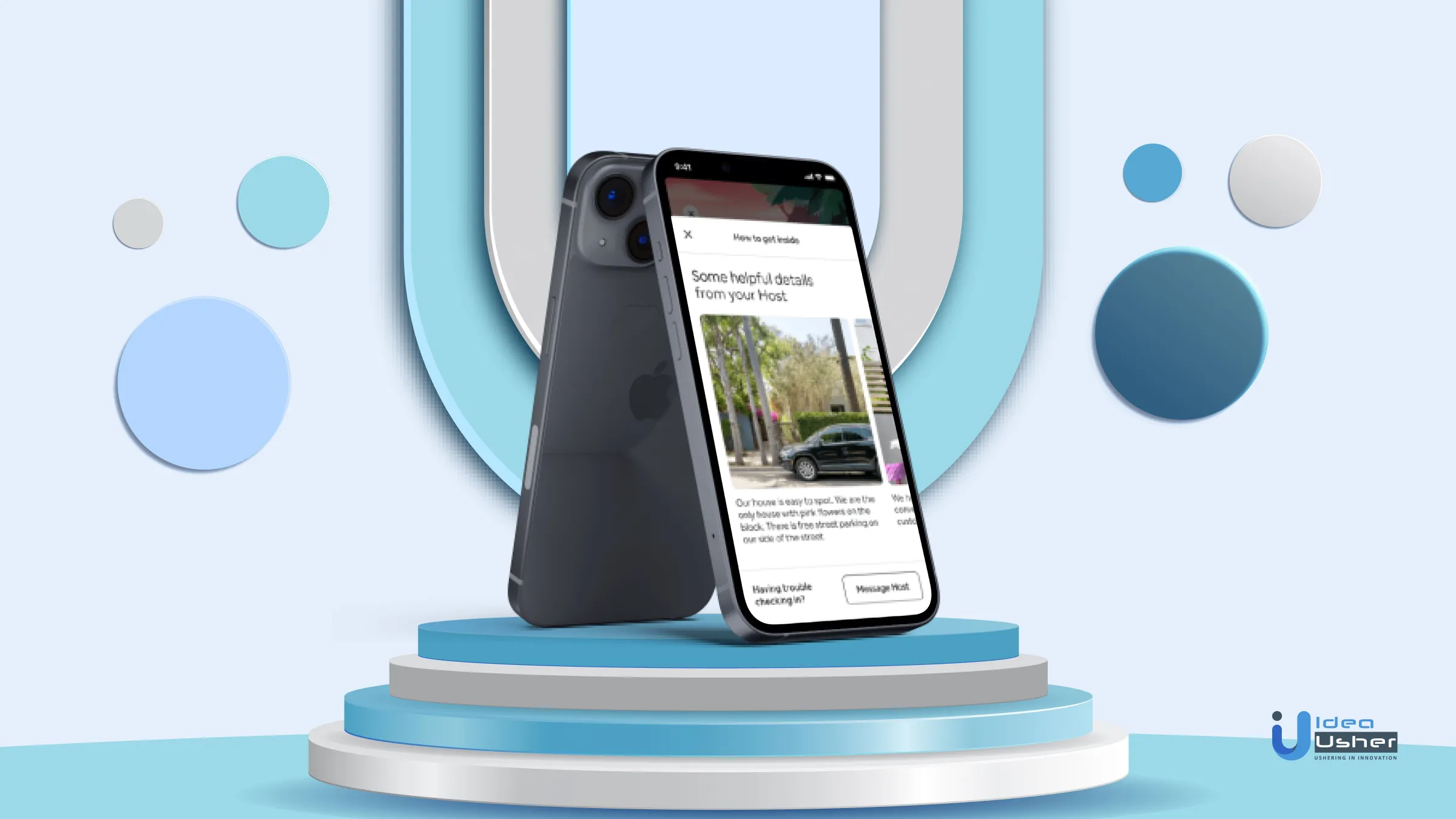
- The host now has to set the price. When a guest is interested, the host can communicate in the application & discuss details such as quiet hours, cleanliness standards, and other things.
- The host can approve the guest’s stay if everything is agreed upon. However, the stay request can also be rejected.
- The host receives the payment 24 hours after the guest checks in. The guest should confirm that the property met all expectations.
Building An App Like Airbnb: Add-on Features To Stand Out
1. Price Calculator
Guests can use the tool to estimate the cost of their lodging and excursions. Furthermore, hosts can set the standard price.
2. Booking Status Reports
It helps to discover more about property listings. You can look at the demographic ideas, the most popular locations, and the revenue amount.
3. Unique Themes
Apps such as Airbnb are available with a variety of themes, allowing users to customize the app. You can incorporate this too!
4. Currency Conversion Feature
Integrated tools that allow app users to easily convert currencies can be included. This feature is ideal for global business.
6. Customized Calendar
Personalized calendars to assist hosts in managing rental house availability are a great feature to include.
Bluetooth Technology & IoT- Bringing Your Home-rental Idea To Life!
Properties (or rooms) can be easily integrated with smart locks & door-to-door QR codes. Bluetooth Low Energy (or BLE) establishes the connection between the smart locks and the users’ phones. A home-rental application armed with a QR-code scanner will allow users to unlock the doors as they reach for them.
Leveraging the power of IoT, a smart solution is created wherein the smart lock on the doors detects the user’s device (with the app). Subsequently, the home-rental app checks into the user database and validates the user request. Upon confirmation, the lock can unveil the QR code, which the user can scan to unlock the door.
Alternatively, the GPS can also be leveraged to enable the automatic unlocking of the smart lock by detecting the user’s immediacy to the property. This paves the way for a hassle-free experience where there is no need for the users to type in a password/pattern or scan the code.
A Step-by-step Guide To Build An App Like Airbnb
Here is a step-by-step guide for you to develop a home-rental booking application similar to Airbnb. This can be helpful for startups who are looking to make an entry into this lucrative space!

1. Analyze The Need, Audience, And Competitors
The first step in creating an app comparable to Airbnb is to stick to your aims while jotting down your objectives.
Make a list of the most important features. Even if you’re creating an app similar to Airbnb, don’t forget to include unique features in order to be successful.
Next, you should make a detailed survey of the audience that these types of apps attract. Zero in on the type of customer base you want to target.
It is also important to assess the market leaders. Get a general idea of the type of competition you will be facing, the pro features of their apps, and how you can edge past them!
2. Consider The App Development Stages
The app development process is usually broken down into four stages. These are ideation, design, development, and deployment. The duration of these stages will depend on the size of the team and the complexity of the project. It also depends on how many developers are working on it.
- Ideation Stage:
This stage is all about brainstorming ideas for the Airbnb-clone app. It entails a lot of research and market analysis. You would like to understand the customer pain points with Airbnb and address them with your app. - Design Stage:
This phase includes wireframing your clone app for the various screens it will be used on. The designers can create mockups to test out different layouts, as well as come up with ways to blend all the app content together for easy navigation. - Development
The developers shape your prototypes in this phase to build the actual app. All working prototypes, app functionality, sketches, storyboards, and workflow charts are taken into account. It usually includes both frontend & backend development. The frontend functionalities should be linked to the backend procedures so that data is seamlessly collected, saved, and processed. - Deployment:
This is where your Airbnb clone app goes live! You can either distribute the app to the store or provide it to the business owner to use in their facilities (in the case of a web application).
3. Wireframing & Designing
It is important to chalk out the app that you are developing, along with its features. The best way to do this is by creating a wireframe of the app. The wireframe serves as a blueprint for the app & guides the developers during the development process. These are made up of grids that show the screens that will feature in the app and the information they will encapsulate.
For an Airbnb clone app, you would like to add features that it is missing! For instance, customers often face problems when the guests cancel stays unilaterally. In your application, you can include a feature that automatically books a nearby stay in such a scenario!
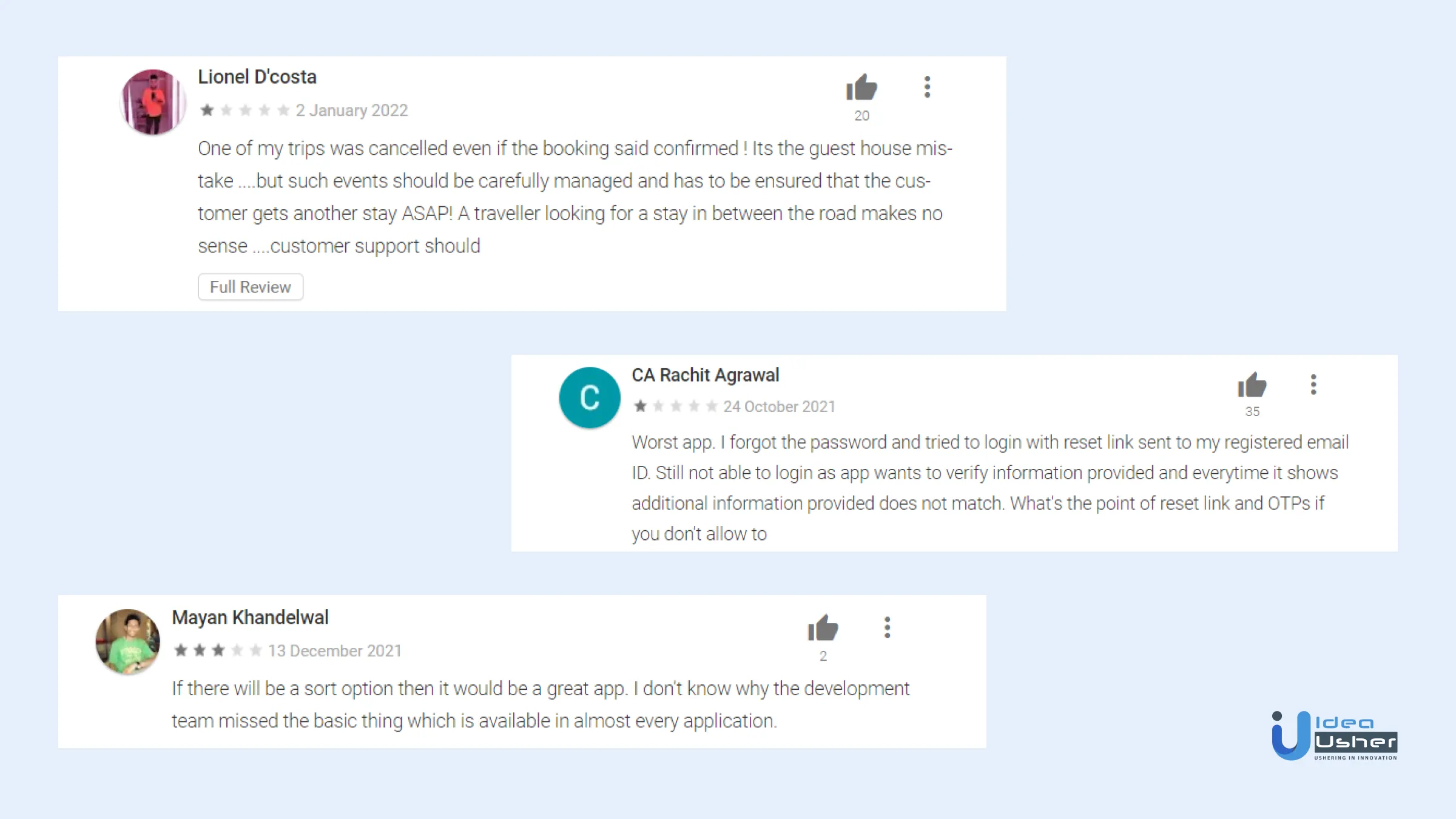
Another instance where you can better the Airbnb app is what’s mentioned by a user named Rachit. It is common for users to forget passwords, and Airbnb does an overkill by matching exact information. While the intention is to ensure security, it doesn’t impress the users if they can’t log in easily if they forget a password! You can try to develop a smoother mechanism for a password reset!
As a user states here, he can’t find the sorting option for stays in the application. While creating the wireframes and designing, you must ensure that such a user-favorite option is included on the home screen.
The moral of the story is that you must understand the customer’s pain points and make a better app to dethrone the first-mover in any industry. Just by going through the feedback, you can lay a solid foundation for your home-rental app in the wireframing and designing stage.
Once you have the wireframes ready, it’s time to start designing them. Designers can create a mockup by including color, images, or icons to represent what each screen would look like in the app.
However, if you’re asking why you should design the app’s UI before coding, one of the primary reasons is that it allows you to achieve your graphics app and visuals goals. To make the various visual qualities usable, backend development team software developers should simply follow the visual guide’s lead in writing codes. As a result, it aids in the reduction of development time and expense.
Build Better Solutions With Idea Usher
Professionals
Projects
4. Select A Source Code Platform
A cross-platform product’s ability to attract a large user base is a misconception. It’s a fact that choosing either of the platforms between Android and iOS when developing a new software like Airbnb is the safest option. Choosing one platform for your application from the start will create a better device environment. You can build for other mobile app platforms as well, depending on the user experience, once you’ve analyzed the market and target audience response to your product.
In terms of data for Android apps for various OS versions, Android has the largest market share, accounting for nearly 80% of all users. As a result, aiming high is ideal. The remaining 20% of iOS users are primarily elites with high power consumption. This suggests that deploying the program on iOS could result in increased short-term trip sales.
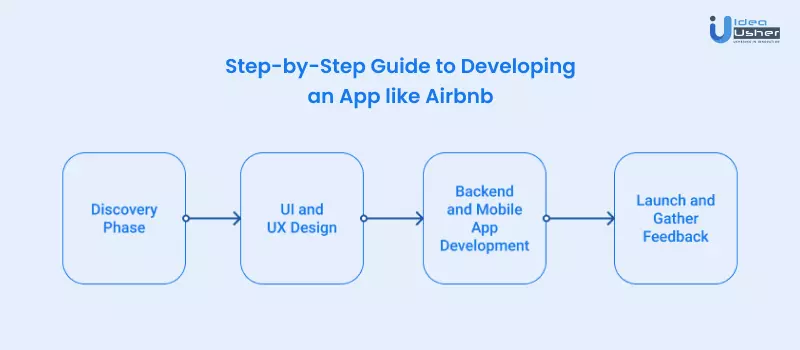
5. Setup Back-end Development
It allows the developer to tweak the backend functionality more easily.
Back-end development is a challenging task that requires a lot of knowledge and experience. However, with the help of some automation tools, it becomes easier to get an idea of what your final product will look like.
One way of automating the process is to use a framework. Some of these frameworks are developed by experts on the backend side, while some are made by experts on the front-end side who also know about server-side programming languages.
6. Putting The Prototype To Test
Once your development team completes the travel app, the testing team will be able to join the phase. The quality assurance analyst team checks to see if your developed Airbnb-like service is working properly. If any defects are discovered, they must be fixed and retested to ensure that users have a positive experience and viability. The mobile application is ready to launch for users once it has completed debugging.
7. Release The Minimal Viable Product (MVP)
As mentioned earlier, the process of building an app should ideally be broken down into the following steps – understand the need, research, design, develop and release. One can use these steps to build a complex app or just build an MVP.
A minimal viable product is basically a prototype that helps you get feedback on what to change in your product. It is used by all types of companies for all sorts of apps. The best part about it is that it doesn’t have to be expensive or complex to develop because it doesn’t do everything an app should do. You can learn more about MVP development stages here.
8. Build CRM/Automate CMS/API Integrations
The inflection point for CRM and CMS automation is now. Automation has been a small part of CRM and CMS for years, but now it has the potential to be the entire engine.
Customers expect fast responses from customer service reps, so it is important to automate as much as possible.
API integrations are a great way to automate various processes in your business, such as sending leads from a form submission on your website directly into Salesforce or sending leads from your Google Ads account straight into HubSpot or Mailchimp instead of having those leads go through long human-based processes before reaching their final destination.
Find a CRM system that best suits your needs, then connect it to your website.
9. Marketing & Product Improvements
Marketing The Product
Marketing should be the first thing that needs to be done after the app is launched. It is all about reaching out to the target audience with a better proposition than your competitors.
To start off, you need a message that allures people and gets them excited about your home-rental app. This can happen through a video, articles, or social media marketing on Facebook, Instagram, or Twitter, depending on your target audience. You can create a catchy tagline like:
“If you want to roam,
With the XXXX app, you #always have a home!”
Product Improvement
If you are serious about consolidating and improving the market share for your Airbnb-clone application, app optimization is important. It will improve the user experience constantly and make it sustainable in the long run.
You can leverage customer feedback or surveys that you could create for your customers. Take their views into account and detect the market sentiment on what they are exactly looking for!
Airbnb Tech Stack
|
Programming languages |
Ruby, JavaScript, HTML5, CSS3 |
|
Application Framework |
Ruby on Rails |
|
JavaScript Framework |
React.js |
|
Automation Frameworks |
RSpec, Capybara, PhantomJS |
|
SQL Data Storage |
PostgreSQL |
|
Global Payment |
Braintree |
|
Cloud Hosting |
Amazon EC2 |
| Voice and SMS API for SMS, Voice, and Phone Verification |
Nexmo |
|
Messaging & Communication |
Twilio |
|
Cloud Storage |
Amazon S3, EBS |

Cost Of Developing A Home-Rental Application Like Airbnb
Companies that produce apps like Airbnb, Uber, and Lyft are constantly innovating with their features. Some of these companies use design standards to make sure that they meet the needs of their customers.
The main reason for the high cost of developing an application that mimics Airbnb is the technical complexity in terms of features and design standards.
Whenever you build an app, be it a rental one like Airbnb or otherwise, there are certain factors that are taken into consideration. Here are some aspects that should be kept in mind:
1. Size Of The Development Team
If you are enthusiastic enough to take on the role of project manager and closely monitor the entire process, you can keep your team small and focused. Aside from developers and designers, you’ll need a project manager, a system administrator, and a few more insider managers.
2. The Type Of Platform(s) Chosen
iOS, Android, iOS, and Android – adds up to several different screens to adjust the app to – all of this should be considered ahead of time based on target audience location, preferred device environment, and other factors. To clarify, Android app development takes approximately 20 to 30% longer than iOS (iPhone) app development.
3. The Technical Complexity Of The Features
Once you have decided on the array of elements you want in your mobile application, you can rate them as per their level of complexity. Keep in mind that the price is largely determined by how long it takes developers to implement.
4. Design Standards
The price will also vary depending on whether you want standardized or customized designs for your app. If you want to use unique visuals and tools for Airbnb app design, the price will reflect that change significantly.
5. Country Of Development
Globally, the cost of developer hours varies. Below are the hourly rates for the average region:
|
Country of the development team |
Average regional hourly rates |
|
The United States and Canada |
$50 to $250/hour |
|
Western Europe |
$30-$170/hour |
|
Eastern Europe |
$20 to $150/hour |
|
Australia |
$50 to $150/hour |
|
India |
$30 to $100/hour |
Monetization Method
There are several ways to monetize a home rental app. One way is by having users pay for the app itself, like Rover. Another is by charging the property owners for posting their homes, like Airbnb. A third way is by having guests pay the property owner directly through an app like HomeAway.
All of these methods have their own advantages and disadvantages. With apps like Rover, there are no fees to list on the app, which means more properties can be listed than with Airbnb or HomeAway. However, with Airbnb and HomeAway you will have more control over your finances because you’re not paying any fees upfront to use either of these services.
There are a few monetization methods that you can cash in on if you own a property rental app-
1. Service Fees
The service fee is the most common way of monetizing a home rental app. This fee varies from country to country, but it always includes listing fees and reservation fees.
2. Exchange Rates
When we convert our money into different currencies, then there is usually an exchange rate fee as well as a conversion fee. So, if you want to rent out your property for more than one week, it might make sense to make sure you charge in US dollars or Euros instead of local currency.
Some apps also charge an exchange rate for currency conversion; this method is used when it is necessary to use the same currency as that of the host country.
What Are The Best Alternatives For Airbnb Available In The Market?
1. Booking.com
Booking.com has always been a top-tier website for online hotel reservations. The site now also allows for the booking of apartments and vacation rentals. Finding the desired hotel, apartment, or vacation rental is never a problem, thanks to the user-friendly interface and quick filtering process.
Also, with Booking.com, unlike Airbnb, upfront payment is not always mandatory.
2. Agoda
Agoda Homes are probably one of the greatest alternatives to Airbnb, which dominates the Asian industry. What genuinely distinguishes Agoda Homes from Airbnb is that it only permits complete flats and homes to be listed. As a result, if you’re a solo traveler, you won’t find many common places in Agoda Homes. Nonetheless, it’s a fantastic approach to locating full estates that can provide you and your family with some seclusion. Furthermore, you will have little to no contact with the hosts and will only need to check in or out of the property.
3. Vrbo
Vrbo is similar to Airbnb but only rents out complete properties and does not provide squat houses, dormitories, or rooms in public areas. It is not as famous as Airbnb, but it has actually been around for a long time. Vrbo contains a list of many full-size holiday homes and apartments, so if you want to rent an affordable property for kids, grandchildren, or pets, this is a good choice.
4. FlipKey
FlipKey is probably one of the greatest Airbnb-like apps. While it may not be as vast as the booking app behemoth, it nonetheless has plenty of wonderful options for short-term getaways. On the platform, there are around 830,000 listings from 190 countries. Of course, this means there are far fewer possibilities than there are on Airbnb.
This app, on the other hand, is a little different in terms of fees. It has two primary fees: a fee for the owner and a non-refundable booking fee. The booking fee ensures that transactions are secure and that customer care is available 24 hours a day, seven days a week. The owner fee, on the other hand, is just an additional price for housekeeping, cleaning, and other services.
Case Study: Success Of Airbnb
Airbnb is huge, and there is no doubt, but a logically smart mind like yours believes in concrete numbers rather than cloudy verbal applause.
According to SimilarWeb, Airbnb is the 4th most popular app in the Travel category in the App Store.
There are over 650k hosts on this app, lots of options for the traveler, don’t you think?
The app holds a strong customer base with over 150m users worldwide.
Airbnb’s services cover eighty-one thousand cities and one hundred and ninety-one countries.
Tech-stack Assured Airbnb’s Long Stay As A Winner
Airbnb is clearly one of the great successes of the digital age. It has taken an activity that had previously been reserved for the rich and made it available to everyone. It has created a huge new market for short-term rentals.
The tech stack behind Airbnb assured its great success in the future.
- One of the reasons Airbnb has done so well is that it uses a technology stack that is also used by other companies.
- Airbnb started out with a pretty typical Rails app, but carefully selected only things it felt comfortable with, not other technologies entirely unfamiliar to them.
- They could have started with something else, but they chose to use web APIs instead of building their own data store, for example. APIs are easy to use, familiar to developers who have used them before and have worked well for many other firms.
- This strategy enabled them to avoid choices that might have seemed obvious at the time but would have turned out later to be mistaken because what looks obvious in retrospect is often not obvious at the time.
In its first year of life, Airbnb hosted roughly 400 guests. Now, after 10 years, roughly 400 guests check in to an Airbnb every two minutes, that’s a check-in increase of 26,280,000%. This is what success looks like!! Share on X
How Does Idea Usher Can Help You In Developing An App Like Airbnb?
With the world shifting to a new age of shared economy, people want to own everything without actually owning them(from cars to homes).
What if you are visiting the US and want to stay like a local there without checking in a restaurant? Well, that’s where a home-rental app comes in! Idea Usher houses expert developers & designers who can understand your idea and conduct comprehensive research on the market scenario, the in-app features that will make the app work, and even guide you to chalk out a sound business model.
They can clone the Airbnb app or even make it better by taking care of everything from the backend to the front end. From the beginning until the end(deployment), the Idea Usher team will maintain constant communication and clear the roadblocks during development.
Idea Usher also offers expertise in marketing and promotion, which is an integral part of any successful application(post-launch).
A Skilled Developer For Every Project Trusted by 100+ clients
FAQs
1. How Do You Make An Airbnb Clone App?
Cloning Airbnb is not as hard as you might think! You just need to set a goal, do in-depth research, include unique user-friendly features, and have a viable business plan. If you are ready with these, the last step is to associate with a reputable app development team who can deliver your vision in style!
2. How Much Does It Cost To Develop An Airbnb Clone Application?
Depending on the service provider, platform, and contract type you choose, hourly prices may vary. As a result, the typical cost of developing an Airbnb clone app for iOS would start at $40 000, while an Android Airbnb clone app would cost at least $50,000.
3. What Benefits Does A Home-rental Application Provide?
A home-rental app facilitates hassle-free travel for customers while allowing property owners across the globe to monetize their unused spaces. By ensuring impeccable features that allow guests to communicate with the hosts, book a space, and have a hyper-local experience, the app adds more fuel to the concept of the shared economy.
By facilitating such a bridge, your application can rival the already-entrenched market leaders and generate revenues!
4. Why did Airbnb Discarded React Native?
The primary reason behind Airbnb discarding React is the complex mechanism of maintaining the language. However, Airbnb had created its own React Native fork, where it directly interfered with the framework’s native code. Thus, they failed to move as speedily as they had wanted.
Final Thoughts
Airbnb is the most successful home-sharing platform in the world. It has achieved this by focusing on customer experience, and of course, it had the first-mover advantage! This article has looked at how Airbnb has grown, why it does well, and what new entrants wishing to build an app like Airbnb can learn from its shortcomings in UI/UX.
While entrepreneurs and startups can try to replicate Airbnb’s success in providing excellent customer experience, they must also try to better Airbnb. For an even more detailed discussion and insights, connect with our experts today and brainstorm your idea!
